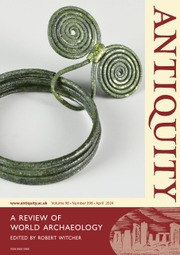No CrossRef data available.
Article contents
The barkcloth beater of Sulawesi and its changes over time
Published online by Cambridge University Press: 23 May 2025
Abstract

The tradition of beating bark to produce cloth probably emerged in South China before spreading to Island Southeast Asia with the Austronesian cultural expansion (5000–3500 BP). Type IV barkcloth beaters found on the island of Sulawesi mark a technological leap from mainland examples and the discovery of 16 such beaters at Buttu Batu pushes the local adoption of this type back to c. 2111–1933 BP. Combining archaeological examples with extensive ethnographic research, the authors document an early-twentieth-century diversification in the patterning of grooves on type IV beaters, revealing a unique innovation aimed at improving barkcloth quality in response to increasing competition.
Information
- Type
- Research Article
- Information
- Copyright
- © The Author(s), 2025. Published by Cambridge University Press on behalf of Antiquity Publications Ltd

